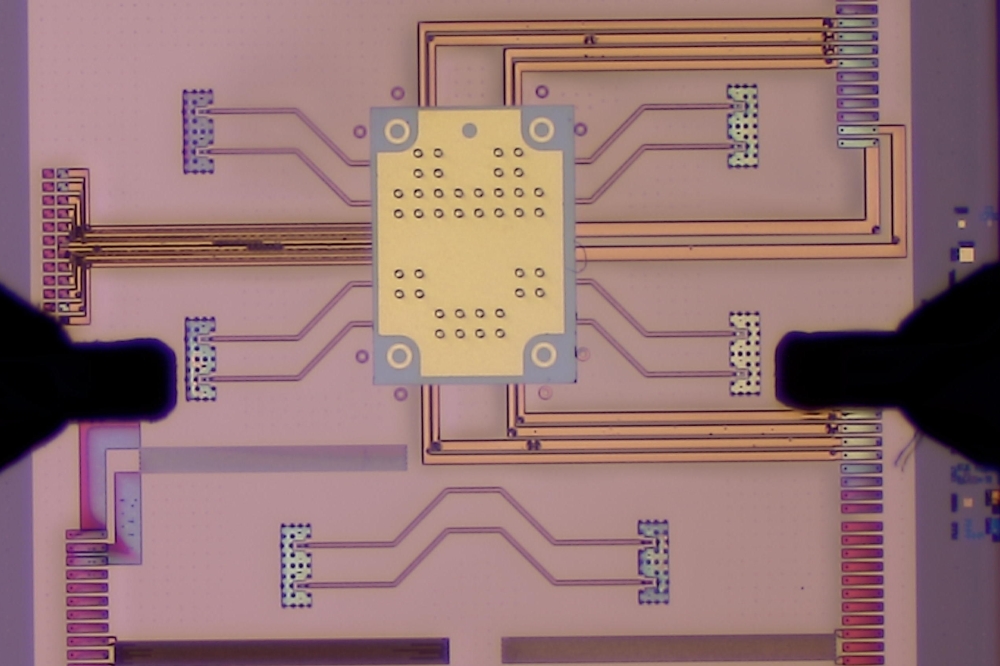JMAR receives XRL development contracts
San Diego, CA. JMAR Technologies Inc. (Nasdaq: JMAR) has announced that its JMAR/JSAL NanoLithography Inc. (JSAL) division located in Burlington, VT has received a $1.2 million contract from a major New England-based aerospace firm to provide a continuing range of X-ray lithography (XRL) support services funded by the Defense Advanced Research Projects Agency (DARPA). In addition, the company has also received a $1.7M development controact from University of Wisconsin.
The New England aerospace contract involves collaboration with the research staff of the University of Vermont (UVM) to conduct semiconductor device demonstrations using point-source XRL technology and other important tasks aimed at advancing the state-of-the-art of XRL.
Under this program JSAL will improve the performance of its current Model 5 stepper by adding a new subsystem known as an Adaptive Wavelength Illumination System. The AWIS will increase the semiconductor wafer processing throughput rate of the stepper by automating certain stepper alignment functions currently performed manually by the operator. JSAL will also replace critical components on the stepper with those built from composite materials, a move that would further enhance the stepper s manufacturing throughput speed and precision.
JSAL will work with the UVM team to perform a series of tasks that, collectively, are called Mask Magnification Correction a method which provides for controlling X-ray mask magnification and demonstrating it on the manufacture of actual semiconductor devices. JSAL Senior Vice President for Technology, Robert Selzer commented, We have been supporting this X-ray lithography program for several years and look forward to continuing to work side-by-side with these dedicated organizations to demonstrate the full potential of point-source XRL as the most effective way to produce the high-performance semiconductor devices needed for several critically important military products programs.
Daniel J. Fleming, Ph.D., president of JSAL concluded, ``This contract continues the work of improving the cost performance benefits of XRL, both now and into the future. We fully expect XRL to be able to produce circuits having feature sizes comparable to, or smaller than, those produceable by other technologies. XRL s advantage is, and will continue to be, its simplicity compared to other Next Generation Lithography (NGL) technologies, resulting in not only a lower overall cost to manufacture very high performance semiconductor devices of all types but to do so at the volume required by industry.
…receives $1.7M order from University of Wisconsin
In more news, JMAR Technologies has joined Mitsubishi Electric and four Universities in a program to further develop its XRL technology. JMAR said its JMAR/SAL NanoLithography division has received a purchase order for $1.7 million from the University of Wisconsin to upgrade one of JSAL s Model 4 X-ray lithography (XRL) steppers, currently installed at the University s Aladdin Synchrotron at the Center for NanoTechnology (CNTech) in Stoughton, Wisconsin.
As part of the order, the University s JSAL Model 4 stepper will be converted into a leading-edge JSAL Model 5C stepper for producing high precision, multi-layer sub-50 nm semiconductor microcircuits. The stepper upgrade is part of a joint program being conducted by the University of Wisconsin s Center for NanoTechnology (CNTech), with subcontracts to JMAR/SAL, Mitsubishi Electric Corporation of Japan (MELCO), the Massachusetts Institute of Technology (MIT), Louisiana State University (LSU), and the University of Vermont (UVM) to further substantiate the viability of the next generation of X-ray lithography as the technology of choice for future high-performance semiconductor processing applications.
John S. Martinez, Ph.D., chairman and chief executive officer of JMAR said, ``This ground-breaking program involves a synergistic collaboration of several of the world s leading academic institutions, companies and scientists in the advanced nanolithography field. It brings together under the leadership of Professor Franco Cerrina, director of CNTech, the world-class expertise of four U.S. universities and two leading industrial companies to address issues that none of these organizations could solve individually to demonstrate the capabilities of Next Generation (proximity) X-ray Lithography (NGX).
The two industrial companies participating in the program are JMAR/SAL NanoLithography Inc., or JSAL, which is providing the high-performance upgraded stepper, and Mitsubishi Electric Corporation (MELCO), which is supplying the world s most advanced X-ray masks.
The university participants in the program include the University of Wisconsin team led by Professor Franco Cerrina, Director of the Center for NanoTechnology; MIT, working under the direction of Professor Henry I. Smith, director of its Nanostructures Laboratory; a Louisiana State University team headed by Professor Martin Feldman; a University of Vermont team under the direction of Professor Dryver Huston, Chairman of the UVM Mechanical Engineering Department.
JMAR understands that the entire collaboration will not involve any exchange of funds between the U.S. and Japan. The company said that the U.S. team is being funded by a combination of Defense Advanced Research Projects Agency (DARPA) and university research funds and that the Japanese program is being financed by Mitsubishi internal funds. The U.S. team will provide a state-of-the-art exposure tool (i.e., the JSAL XRS 2000 stepper) connected to a CNTech synchrotron X-ray beamline where the photon energy can be set to different levels to determine the operating parameters for producing the optimum results.
Robert Selzer, senior vice president for Technology at JMAR/SAL NanoLithography Inc., stated, Proximity X-ray Lithography is the only lithography technique that has been able to produce large-area, high-resolution patterns and semiconductor devices at the smallest resolutions recorded to date. The most recent test results from Japan indicate that the major technology problems involved in implementing PXL have been solved, or are close to being solved. It now appears that establishing a process for XRL capable of 50 to 30 nanometer resolution may be done in a time frame much shorter than previously anticipated.
The upgrades to be made to our JSAL stepper under this program will create the most advanced XRL stepper ever made, Selzer noted. This stepper is expected to be capable of exposing and processing wafers with highly reproduceable and precision positioned linewidths of 70 to 50 nanometers, and smaller. Additionally, the stepper will contain a composite stage to ensure reproduceable results. We believe that it will have wafer processing throughput rates in excess of 30 wafer levels per hour, as well as many other advanced features, including the novel Interferometric Broad Band Imaging (IBBI) advanced alignment system from MIT.
Selzer continued, The central idea of this demonstration originally proposed by T. Kitayama in Japan, involves the use of novel diamond substrate X-ray masks developed by Mitsubishi in Japan. They have already demonstrated the ability to pattern masks having 35 nm features with excellent clarity of the smallest size features. The Japanese team will make available to the project this inhouse mask technology which JMAR believes is the most advanced in the world. It is based on the use of tungsten: titanium absorbers patterned on a 3 to 4 micron thick diamond substrate. JMAR continues to make impressive progress in completing the integration of its X-ray point source with a JSAL stepper for introduction into the compound semiconductor (i.e., gallium arsenide, etc.) market by the end of 2002, Daniel J. Fleming, Ph.D., president of JSAL said. While we see significant opportunities for us in that market, JMAR s ultimate goal has always been to provide a cost-effective solution for the NGL needs of the mainstream silicon market. This exciting new program will lead the way toward meeting these goals. When the objectives of this program are met, we believe X-ray lithography will have established itself as a solid front runner in the race to become the lithography system of choice for many Next Generation Lithography applications.
I believe the significant advancements we have made to date in X-ray lithography, together with the strong endorsement reflected in the commitment of the other esteemed organizations which have chosen to participate in this program, sends a very clear message to industry, Dr. Martinez concluded. The message is that X-ray lithography not only can be the process of choice for future high-performance semiconductor manufacturing, but it should be the process of choice based on the clear cost and performance advantages it could deliver.
JMAR Technologies Inc., is the world s leading developer and manufacturer of semiconductor X-ray lithography sources and systems and is a leading developer of proprietary advanced laser, X-ray and EUV light sources for other high-value microelectronics products. In addition, JMAR manufactures precision measurement, positioning and light-based manufacturing systems for inspection and repair of semiconductors and continues to play an important role in adapting its precision semiconductor manufacturing technology to the fabrication of computer disk drive, advanced biomedical and optical communications products. It is also a fabless provider of high performance integrated circuits for the rapidly growing broadband information transfer market and other microelectronics applications.
The statements herein regarding JMAR s expectations for the successful development and introduction of new products and future sales and potential business opportunities are forward-looking statements based on current expectations that are subject to risks and uncertainties that could cause actual results to differ materially from those set forth in the forward-looking statements. These risks include the failure of advanced technology and new intellectual property to perform as predicted or to be fully developed and engineered in a commercial product that is accepted by the marketplace, the failure of pending patents to be issued, competition from alternative technologies, the failure of future orders to materialize as expected, delays in shipment or production, parts and labor shortages, cancellation or re-scheduling of orders, delay in funding of third-party contracts, and the other risks detailed in the company s 2000 Form 10-K and other reports filed with the SEC.
Contact:
JMAR Technologies Inc., San Diego Dennis E. Valentine
Tel: 760 602-3292
or
JMAR/SAL NanoLithography Inc. Robert Selzer
Tel: 802 652-0055
rselzer@nanolitho.com
or Rubenstein Investor Relations
Tim Clemensen
Tel: 212/843-9337
tclemensen@rubensteinir.com
© Institute of Physics Publishing.
JMAR Technologies Inc., San Diego Dennis E. Valentine
Tel: 760 602-3292
or
JMAR/SAL NanoLithography Inc. Robert Selzer
Tel: 802 652-0055
rselzer@nanolitho.com
or Rubenstein Investor Relations
Tim Clemensen
Tel: 212/843-9337
tclemensen@rubensteinir.com
© Institute of Physics Publishing.
E-mail: tclemensen@rubensteinir.com































